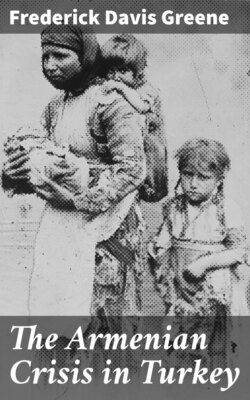Читать книгу The Armenian Crisis in Turkey - Frederick Davis Greene - Страница 16
На сайте Литреса книга снята с продажи.
METHODS OF PROCEDURE AND INCIDENTS OF THE MASSACRE.
ОглавлениеAt first the Kourds were set on, and the troops kept out of sight. The villagers, put to the fight, and thinking they had only the Kourds to do with, repulsed them on several occasions. The Kourds were unwilling to do more unless the troops assisted. Some of the troops assumed Kourdish dress, and helped them in the fight with more success. Small companies of troops entered several villages, saying they had come to protect them as loyal subjects, and were quartered among the houses. In the night they arose and slew the sleeping villagers, man, woman, and child.
By this time those in other villages were beginning to feel that extermination was the object of the government, and desperately determined to sell their lives as dearly as possible. And then began a campaign of butchery that lasted some twenty-three days, or, roughly, from the middle of August to the middle of September. The Ferik Pasha [Marshal Zekki Pasha], who came post-haste from Erzingan, read the Sultan’s firman for extermination, and then, hanging the document on his breast, exhorted the soldiers not to be found wanting in their duty. On the last day of August, the anniversary of the Sultan’s accession, the soldiers were especially urged to distinguish themselves, and they made it the day of the greatest slaughter. Another marked day occurred a few days earlier, being marked by the occurrence of a wonderful meteor.
No distinctions were made between persons or villages, as to whether they were loyal and had paid their taxes or not. The orders were to make a clean sweep. A priest and some leading men from one village went out to meet an officer, taking in their hands their tax receipts, declaring their loyalty, and begging for mercy; but the village was surrounded, and all human beings put to the bayonet. A large and strong man, the chief of one village, was captured by the Kourds, who tied him, threw him on the ground, and, squatting around him, stabbed him to pieces.
At Galogozan many young men were tied hand and foot, laid in a row, covered with brushwood and burned alive. Others were seized and hacked to death piecemeal. At another village a priest and several leading men were captured, and promised release if they would tell where others had fled, but, after telling, all but the priest were killed. A chain was put around the priest’s neck, and pulled from opposite sides till he was several times choked and revived, after which several bayonets were planted upright, and he raised in the air and let fall upon them.
The men of one village, when fleeing, took the women and children, some five hundred in number, and placed them in a sort of grotto in a ravine. After several days the soldiers found them, and butchered those who had not died of hunger.
Sixty young women and girls were selected from one village and placed in a church, when the soldiers were ordered to do with them as they liked, after which they were butchered.
In another village fifty choice women were set aside and urged to change their faith and become hanums in Turkish harems, but they indignantly refused to deny Christ, preferring the fate of their fathers and husbands. People were crowded into houses which were then set on fire. In one instance a little boy ran out of the flames, but was caught on a bayonet and thrown back.
Children were frequently held up by the hair and cut in two, or had their jaws torn apart. Women with child were ripped open; older children were pulled apart by their legs. A handsome, newly wedded couple fled to a hilltop; soldiers followed, and told them they were pretty and would be spared if they would accept Islam, but the thought of the horrible death they knew would follow did not prevent them from confessing Christ.
The last stand took place on Mount Andoke [south of Moosh], where some thousand persons had sought refuge. The Kourds were sent in relays to attack them, but for ten or fifteen days were unable to get at them. The soldiers also directed the fire of their mountain guns on them, doing some execution. Finally, after the besieged had been without food for several days, and their ammunition was exhausted, the troops succeeded in reaching the summit without any loss, and let scarcely a man escape.
Now all turned their attention to those who had been driven into the Talvoreeg district. Three or four thousand of the besieged were left in this small plain. When they saw themselves thickly surrounded on all sides by Turks and Kourds, they raised their hands to heaven with an agonizing moan for deliverance. They were thinned out by rifle shots, and the remainder were slaughtered with bayonets and swords, till a veritable river of blood flowed from the heaps of the slain.
And so ended the massacre, for the timely arrival of the Mushire [Commander-in-chief of the Fourth Army Corps at Erzingan] saved a few prisoners alive, and prevented the extermination of four more villages that were on the list to be destroyed, among which was the Protestant village of Havodorick. This was the formidable army the government had massed so many troops and Kourds to vanquish.
So far as is known, not more than ten or fifteen outsiders were among them, and all told it is not likely they had more than one hundred breechloading rifles.
